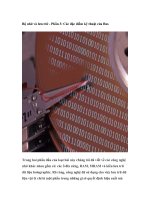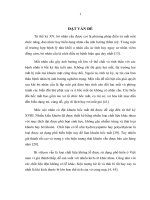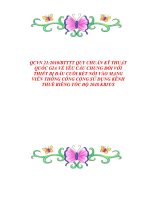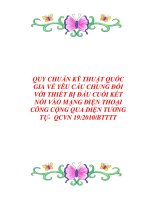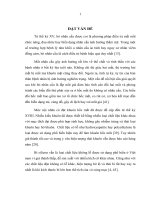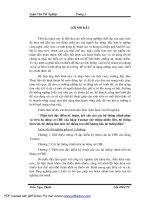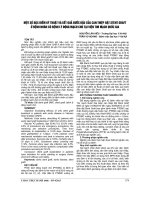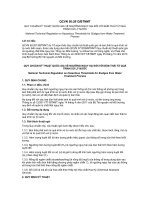Tiêu chuẩn ASTM A 961
Bạn đang xem bản rút gọn của tài liệu. Xem và tải ngay bản đầy đủ của tài liệu tại đây (45.14 KB, 8 trang )
Designation: A 961 – 04
Standard Specification for
Common Requirements for Steel Flanges, Forged Fittings,
Valves, and Parts for Piping Applications1
This standard is issued under the fixed designation A 961; the number immediately following the designation indicates the year of
original adoption or, in the case of revision, the year of last revision. A number in parentheses indicates the year of last reapproval. A
superscript epsilon (e) indicates an editorial change since the last revision or reapproval.
text and the tables, the SI units are shown in brackets. The
values stated in each system are not exact equivalents; therefore each system must be used independently of the other.
Combining values from the two systems may result in nonconformance with the specification. The inch-pound units shall
apply, unless the “M” designation (SI) of the product specification is specified in the order.
1. Scope*
1.1 This specification covers a group of common requirements that shall apply to steel flanges, forged fittings, valves,
and parts for piping applications under any of the following
individual product specifications:
Title of Specification
ASTM Designation
Forgings, Carbon Steel, for Piping Components
Forgings, Carbon Steel, for General-Purpose Piping
Forged or Rolled Alloy-Steel Pipe Flanges, Forged
Fittings, and Valves and Parts for High Temperature
Service
Forgings, Carbon and Low Alloy Steel, Requiring Notch
Toughness Testing for Piping Components
Forged or Rolled 8 and 9 % Nickel Alloy
Steel Flanges, Fittings, Valves, and Parts
for Low-Temperature Service
Forgings, Carbon and Alloy Steel, for Pipe Flanges,
Fittings, Valves, and Parts for High-Pressure
Transmission Service
Flanges, Forged, Carbon and Alloy Steel for Low
Temperature Service
Forgings, Carbon Steel, for Piping Components with
Inherent Notch Toughness
Forgings, Titanium-Stabilized Carbon Steel, for
Glass-Lined Piping and Pressure Vessel Service
A 105/A 105M
A 181/A 181M
A 182/A 182M
2. Referenced Documents
2.1 ASTM Standards: 2
A 105/A 105M Specification for Carbon Steel Forgings for
Piping Applications
A 181/A 181M Specification for Carbon Steel Forgings for
General-Purpose Piping
A 182/A 182M Specification for Forged or Rolled AlloySteel Pipe Flanges, Forged Fittings, and Valves and Parts
for High-Temperature Service
A 275/A 275M Test Method for Magnetic Particle Examination of Steel Forgings
A 350/A 350M Specification for Carbon and Low-Alloy
Steel Forgings, Requiring Notch Toughness Testing for
Piping Components
A 370 Test Methods and Definitions for Mechanical Testing
of Steel Products
A 522/A 522M Specification for Forged or Rolled 8 and
9 % Nickel Alloy Steel Flanges, Fittings, Valves, and Parts
for Low-Temperature Service
A 694/A 694M Specification for Carbon and Alloy Steel
Forgings for Pipe Flanges, Fittings, Valves, and Parts for
High-Pressure Transmission Service
A 700 Practices for Packaging, Marking, and Loading
Methods for Steel Products for Domestic Shipment
A 707/A 707M Specification for Forged Carbon and Alloy
Steel Flanges for Low-Temperature Service
A 727/A 727M Specification for Carbon Steel Forgings, for
Piping Components with Inherent Notch Toughness
A 350/A 350M
A 522/A 522M
A 694/A 694M
A 707/A 707M
A 727/A 727M
A 836/A 836M
1.2 In case of conflict between a requirement of the individual product specification and a requirement of this general
requirement specification, the requirements of the individual
product specification shall prevail over those of this specification.
1.3 By mutual agreement between the purchaser and the
supplier, additional requirements may be specified (see Section
4.1.2). The acceptance of any such additional requirements
shall be dependent on negotiations with the supplier and must
be included in the order as agreed upon between the purchaser
and supplier.
1.4 The values stated in either inch-pound units or SI units
(metric) are to be regarded separately as standard. Within the
1
This specification is under the jurisdiction of ASTM Committee A01 on Steel,
Stainless Steel, and Related Alloys and is the direct responsibility of Subcommittee
A01.22 on Steel Forgings and Wrought Fittings for Piping Applications and Bolting
Materials for Piping and Special Purpose Applications.
Current edition approved March 1, 2004. Published April 2004. Originally
approved in 1996. Last previous edition approved in 2002 as A 961–02.
2
For referenced ASTM standards, visit the ASTM website, www.astm.org, or
contact ASTM Customer Service at For Annual Book of ASTM
Standards volume information, refer to the standard’s Document Summary page on
the ASTM website.
*A Summary of Changes section appears at the end of this standard.
Copyright © ASTM International, 100 Barr Harbor Drive, PO Box C700, West Conshohocken, PA 19428-2959, United States.
1
A 961 – 04
3.2.6 seamless tubing, n—a tubular product made without a
welded seam.
3.2.6.1 Discussion—It is manufactured usually by hot
working the material, and if necessary, by subsequently cold
finishing the hot worked tubular product to produce the desired
shape, dimensions and properties.
A 751 Test Methods, Practices, and Terminology for
Chemical Analysis of Steel Products
A 836/A 836M Specification for Titanium-Stabilized Carbon Steel Forgings for Glass-Lined Piping and Pressure
Vessel Service
A 941 Terminology Relating to Steel, Stainless Steel, Related Alloys, and Ferroalloys
A 967 Specification for Chemical Passivation Treatments
for Stainless Steel Parts
A 991/A 991M Test Method for Conducting Temperature
Uniformity Surveys of Furnaces Used to Heat Treat Steel
Products
B 880 Specification for General Requirements for Chemical
Check Analysis Limits for Nickel, Nickel Alloys and
Cobalt Alloys
E 165 Test Method for Liquid Penetrant Examination
E 381 Method of Macroetch Testing Steel Bars, Billets,
Blooms, and Forgings
E 709 Guide for Magnetic Particle Examination
E 1916 Guide for Identification and/or Segregation of
Mixed Lots of Metals
2.2 ASME Standard:3
ASME Boiler and Pressure Vessel Code–Section IX
2.3 Military Standard:4
MIL-STD-163 Steel Mill Products, Preparation for Shipment and Storage
2.4 Manufacturer’s Standardization Society Standard:5
SP 25 Standard Marking System of Valves, Fittings,
Flanges and Unions
4. Ordering Information
4.1 It is the purchaser’s responsibility to specify in the
purchase order all ordering information necessary to purchase
the needed material. Examples of such information include, but
are not limited to, the following:
4.1.1 Quantity,
4.1.2 Size and pressure class or dimensions, (tolerances and
surface finishes should be included),
4.1.3 Specification number with grade or class, or both, as
applicable, and year/date,
4.1.4 Supplementary requirements, and
4.1.5 Additional requirements.
5. Melting Process
5.1 Unless otherwise specified in the individual Product
Specification, the steel shall be fully killed.
5.2 If a specific type of melting is required by the purchaser,
it shall be stated on the purchase order.
5.3 The primary melting may incorporate separate degassing or refining and may be followed by secondary melting,
such as electroslag remelting or vacuum remelting. If secondary melting is employed, the heat shall be defined as all of the
ingot remelted from a single primary heat.
5.4 Steel may be cast in ingots or may be strand cast. When
steel of different grades is sequentially strand cast, identification of the resultant transition material is required. The steel
producer shall remove the transition material by an established
procedure that positively separates the grades.
5.5 A sufficient discard shall be made from the source
material to secure freedom from injurious porosity and shrinkage, and undue segregation.
3. Terminology
3.1 Definitions—For definitions of other terms used in this
specification, refer to Terminology A 941.
3.2 Definitions of Terms Specific to This Standard:
3.2.1 bar, n—a solid rolled or forged section that is long in
relationship to its cross sectional dimensions, with a relatively
constant cross section throughout its length and a wrought
microstructure.
3.2.2 certifying organization, n—the company or association responsible for the conformance of, and marking of, the
product to the specification requirements.
3.2.3 fitting, n—a component for non-bolted joints in piping
systems.
3.2.4 flange, n—a component for bolted joints used in
piping systems.
3.2.5 forging, n—the product of a substantially compressive
hot or cold plastic working operation that consolidates the
material and produces the required shape.
3.2.5.1 Discussion—The plastic working must be performed by a forging machine, such as a hammer, press, or ring
rolling machine, and must deform the material to produce a
wrought structure throughout the material cross section.
6. Manufacture
6.1 The finished part shall be manufactured from a forging
that is as close as practicable to the finished size or shape.
Alternative starting materials may be used, but with the
following exceptions and requirements.
6.1.1 Bar—Flanges, elbows, return bends, tees, and header
tees shall not be machined directly from bar. Other hollow
cylindrical shaped parts up to, and including, NPS 4 can be
machined from bar provided that the axial length of the part is
approximately parallel to the metal flow lines of the starting
stock.
6.1.2 Seamless Tubing—Flanges shall not be machined
directly from seamless tubing. Other hollow cylindrical shaped
parts up to, and including NPS 4, can be machined from
seamless tubing provided that the axial length of the part is
approximately parallel to the metal flow lines of the starting
stock.
3
Available from the American Society of Mechanical Engineers, Three Park
Avenue, New York, NY 10016–5990.
4
Available from Standardization Documents Order Desk, Bldg. 4, Section D,
700 Robbins Ave., Philadelphia, PA 19111-5094, Attn: NPODS.
5
Available from the Manufacturers Standardization Society of the Valve and
Fittings Industry (MSS), 127 Park Street, NW., Vienna, VA 22180.
2
A 961 – 04
specification, within the permissible variations of Table 1 or
Table 2 of this specification, as appropriate for the grade being
supplied.
7. Heat Treatment
7.1 Material requiring heat treatment shall be treated as
specified in the individual product specification using the
following procedures that are defined in more detail in Terminology A 941.
7.1.1 Full Annealing—Material shall be uniformly reheated
to a temperature above the transformation range and, after
holding for a sufficient time at this temperature, cooled slowly
to a temperature below the transformation range.
7.1.2 Solution Annealing—Material shall be heated to a
temperature that causes the chrome carbides to go into solution, and then, quenched in water or rapidly cooled by other
means to prevent reprecipitation.
7.1.3 Isothermal Annealing—Isothermal annealing shall
consist of austenitizing a ferrous alloy, and then, cooling to and
holding within the range of temperature at which the austenite
transforms to a relatively soft ferrite-carbide aggregate.
7.1.4 Normalizing— Material shall be uniformly reheated to
a temperature above the transformation range, and subsequently, cooled in air at room temperature.
7.1.5 Tempering and Post-Weld Heat Treatment—Material
shall be reheated to the prescribed temperature below the
transformation range, held at temperature for the greater of 30
min or 1 h/in. [25.4 mm] of thickness at the thickest section and
cooled in still air.
7.1.6 Stress Relieving— Material shall be uniformly heated
to the selected stress relieving temperature. The temperature
shall not vary from the selected temperature by more than
625°F [614°C].
7.1.7 Quench and Temper—Material shall be fully austenitized and quenched immediately in a suitable liquid medium.
The quenched fittings shall be reheated to a minimum temperature of 1100°F [590°C] and cooled in still air.
9. Mechanical Requirements
9.1 Method of Mechanical Tests—All tests shall be conducted in accordance with Test Methods and Definitions A 370.
9.2 For the purpose of determining conformance to the
product specification requirements, specimens shall be obtained from the production forgings, or from separately forged
test blanks prepared from the stock used to make the finished
product. In either case, mechanical test specimens shall not be
removed until after all heat treatment is complete. If repair
welding is performed, test specimens shall not be removed
TABLE 1 Product Analysis Tolerances for Higher Alloy and
Stainless SteelsA
Element
Limit or Maximum of
Specified Range, Wt %
Tolerance Over the
Maximum Limit or
Under the Minimum
Limit
Carbon
0.030, incl
over 0.030 to 0.20 incl.
to 1.00 incl.
over 1.00 to 3.00 incl.
over 3.00 to 6.00
over 6.00 to 10.00
to 0.040, incl.
over 0.040 to 0.20, incl.
to 0.030, incl.
to 1.00, incl.
over 1.00 to 5.00 incl.
over 4.00 to 10.00 incl.
over 10.00 to 15.00 incl.
over 15.00 to 20.00 incl.
over 20.00 to 27.50 incl.
to 1.00 incl.
over 1.00 to 5.00 incl.
over 5.00 to 10.00 incl.
over 10.00 to 20.00 incl.
over 20.00 to 22.00 incl.
to 0.20 incl.
over 0.20 to 0.60 incl.
over 0.60 to 2.00 incl.
over 2.00 to 7.00 incl.
all ranges
all ranges
0.005
0.01
0.03
0.04
0.05
0.06
0.005
0.010
0.005
0.05
0.10
0.10
0.15
0.20
0.25
0.03
0.07
0.10
0.15
0.20
0.01
0.03
0.05
0.10
0.05
0.05
0.05 to 0.20 incl.
to 0.10 incl.
to 0.50, incl.
over 0.50 to 1.00, incl.
over 1.00 to 3.00, incl.
over 3.00 to 5.00, incl.
over 5.00 to 10.00, incl.
0.05 to 0.20 incl.
to 0.19 incl
over 0.19 to 0.25
over 0.25 to 0.35
over 0.35 to 0.45
over 0.45 to 0.60
to 0.05 incl.
to 0.10 incl.
over 0.10 to 0.25 incl.
0.03 to 0.08
0.01
0.02
0.03
0.05
0.10
0.15
0.20
0.01B
0.01
0.02
0.03
0.04
0.05
0.01
0.01
0.02
−0.005
+0.01
Manganese
Phosphorous
Sulfur
Silicon
Chromium
Nickel
8. Chemical Requirements
8.1 Chemical Analysis—Samples for chemical analysis and
methods of analysis shall be in accordance with Test Methods,
Practices, and Terminology A 751.
8.2 Heat Analysis—An analysis of each heat of steel shall
be made by the steel manufacturer to determine the percentages
of those elements specified in the individual product specification. If secondary melting processes are employed, the heat
analysis shall be obtained from one remelted ingot, or the
product of one remelted ingot, from each primary melt. The
chemical analysis thus determined shall conform to the requirements of the individual product specification. Note that the
product analysis (check analysis) tolerances are not to be
applied to the Heat Analysis requirements.
8.3 Product Analysis—If a product analysis is performed it
shall be in accordance with Test Methods, Practices, and
Terminology A 751. Samples for analysis shall be taken from
midway between center and surface of solid parts, midway
between inner and outer surfaces of hollow parts, midway
between center and surface of full-size prolongations or from
broken mechanical test specimens. The chemical composition
thus determined shall conform to the limits of the product
Molybdenum
Titanium
Columbium (Niobium)
+ Tantalum
Columbium (Niobium)
Tantalum
Copper
Cobalt
Nitrogen
Aluminum
Vanadium
Cerium
A
This table does not apply to heat analysis.
Product analysis limits for cobalt under 0.05 % have not been established and
the producer should be consulted for those limits.
B
3
A 961 – 04
TABLE 2 Product Analysis Tolerances for Low Alloy SteelsA
Tolerance Over Maximum Limit or Under Minimum Limit for Size Ranges Shown, Wt %B
Element
Limit or Maximum of
Specified Range, Wt %
100 in.2(6.453 104
mm2), or less
Over 100 to 200 in.2
(1.2903 105 mm2), incl
Over 200 to 400 in.2
(2.581 3 105 mm2), incl
Over 400 in.2
Mn
to 0.90 incl
over 0.90 to 1.00
to 0.045 incl
to 0.045 incl
to 0.40 incl
over 0.40 to 1.00
to 0.90 incl
over 0.90 to 2.10
over 2.10 to 3.99
to 0.50
to 0.20 incl
over 0.20 to 0.40
over 0.40 to 1.15
to 1.00 incl
over 1.00 to 2.00
to 0.10
to 0.10 incl
over 0.10 to 0.25
over 0.25 to 0.50
0.03
0.04
0.005
0.005
0.02
0.05
0.03
0.05
0.10
0.03
0.01
0.02
0.03
0.03
0.05
0.01
0.01
0.02
0.03
0.04
0.05
0.010
0.010
0.02
0.06
0.04
0.06
0.10
0.03
0.01
0.03
0.04
0.03
0.05
0.01
0.01
0.02
0.03
0.05
0.06
0.010
0.010
0.03
0.06
0.04
0.06
0.12
0.03
0.02
0.03
0.05
0.03
0.05
0.01
0.01
0.02
0.03
0.06
0.07
0.010
0.010
0.04
0.07
0.05
0.07
0.14
0.03
0.03
0.04
0.06
0.03
0.05
0.01
0.01
0.02
0.03
P
S
Si
Cr
Ni
Mo
Cu
Ti
V
A
B
incl
incl
incl
incl
incl
incl
incl
incl
Product Analysis for C, B, Cb and Ca shall conform to the Product Specification.
Cross-sectional area.
until after post-weld heat treatment is complete, unless permitted by the product specification. The locations from which test
specimens are removed shall be in accordance with the Product
Specification.
9.3 If separately forged test blanks are used, they shall be of
the same heat of steel, be subjected to substantially the same
reduction and working as the production forging they represent, be heat treated in the same furnace charge except as
provided for in the reduced testing provisions of the product
specification, under the same conditions as the production
forging, and be of the same nominal thickness as the maximum
heat treated thickness of the production forging.
9.4 When parts are machined from bar or seamless tubing,
as permitted in 6.1.1 and 6.1.2, the mechanical properties may
be determined for the parts from the starting material, if the
parts have not been subjected to any subsequent thermal
processing since the time of mechanical test.
11.4 The results of the tensile tests shall conform to the
tensile property requirements prescribed in the product specification.
11.5 If the results of tension tests do not conform to the
requirements specified in the product specification, retests are
permitted as outlined in Test Methods and Definitions A 370. If
the results of any tension test specimen are less than specified
because a flaw becomes evident in the test specimen during
testing, a retest shall be allowed provided that the defect is not
attributable to ruptures, cracks, or flakes in the steel.
12. Impact Requirements
12.1 The part shall conform to the impact requirements
prescribed in the product specification.
12.2 Sampling for impact testing shall conform to the
Product Specification.
12.3 If the average impact energy value meets the product
specification requirements, but the energy value for one specimen is below the specified minimum value for individual
specimens, a retest is permitted. This shall consist of two
impact specimens from a location adjacent to, and on either
side of, the specimen that failed. Each of the retested specimens must exhibit an energy value equal to or greater than the
minimum average value required by the product specification.
10. Hardness Requirements
10.1 The part shall conform to the hardness requirements
prescribed in the product specification.
10.2 Sampling for hardness testing shall conform to the
product specification.
11. Tensile Requirements
11.1 Sampling for tensile testing shall conform to the
Product Specification.
11.2 When the dimensions of the material to be tested will
permit, the tension test specimens shall be machined to
standard round 2-in. [50-mm] gage length tension test specimen described in Test Methods and Definitions A 370.
11.3 In the case of small sections, which will not permit
taking of the standard test specimen described in 11.2, the
subsize round specimen shall be machined as described in Test
Methods and Definitions A 370. The tension test specimen
shall be as large as feasible.
13. Hydrostatic Test Requirements
13.1 Parts manufactured under this specification shall be
capable of passing a hydrostatic test compatible with the rating
of the finished part. Such tests shall be conducted by the
supplier only when the hydrostatic test supplementary requirement in the product specification is invoked by the purchaser.
14. Rework
14.1 When one or more representative test specimens or
retest specimens do not conform to the requirements specified
4
A 961 – 04
permitted at the discretion of the supplier. All weld repairs shall
be performed in accordance with the following limitations and
requirements.
16.1.1 The welding procedure and welders shall be qualified
in accordance with Section IX of the ASME Boiler and
Pressure Vessel Code.
16.1.2 Defects shall be completely removed prior to welding by chipping or grinding to sound metal. Removal of these
defects shall be verified by magnetic particle inspection in
accordance with Test Method A 275/A 275M or Guide E 709
for the ferritic, martensitic, or ferritic/austenitic grades, or by
liquid penetrant inspection in accordance with Test Method
E 165 for ferritic, martensitic, or austenitic grades.
16.1.3 After repair welding, the welded area shall be ground
smooth to the original contour and shall be completely free of
defects as verified by magnetic particle or liquid penetrant
inspection, as applicable.
16.1.4 Repair by welding shall not exceed 10 % of the
surface area of the part, or 331⁄3 % of the wall thickness of the
finished product, or 3⁄8 in. [10 mm] deep at the location of the
repair.
16.2 The weld repair shall conform to 9.2 and to the
additional requirements, if any, invoked in the Product Specification.
in the product specification for the tested characteristic, the
product may be reworked according to the following requirements:
14.1.1 If previously tested in the unheat treated condition,
the product may be reworked by heat treatment, and subsequently retested, in accordance with the product specification.
14.1.2 If previously tested in the heat treated condition, the
product may be reworked by reheat treatment, and subsequently retested, in accordance with the product specification.
15. Finish and Appearance
15.1 The parts shall conform to the dimensions, tolerances,
and finish as specified on the purchaser’s drawing or order.
15.2 The finished parts shall be cleaned to remove all scale
and processing compounds prior to the final surface examination. The cleaning process shall not injure the surface finish,
material properties, or the metallurgical structure. The cleaned
parts shall be protected to prevent recontamination. Protective
coatings on parts subsequently subjected to socket welds or
butt welds shall be suitable for welding without removal of the
coating. When specified in the purchase order, parts may be
furnished in the as-formed or as-forged condition.
15.3 The parts shall be free of injurious imperfections as
defined below. At the discretion of the inspector representing
the purchaser, finished parts shall be subject to rejection if
surface imperfections acceptable under 15.5 are not scattered,
but appear over a large area.
15.4 Depth of Injurious Imperfections—Selected typical
linear and other typical surface imperfections shall be explored
for depth. When the depth encroaches on the minimum
specified wall thickness of the finished part, such imperfections
shall be considered injurious.
15.5 Imperfections Not Classified as Injurious—Surface
imperfections not classified as injurious shall be treated as
follows:
15.5.1 Seams, laps, tears, or slivers not deeper than 5 % of
the actual wall thickness at the point of interest or 1⁄16 in. [1.6
mm], whichever is less, are acceptable. If deeper, these
imperfections require removal, and shall be removed by
machining or grinding.
15.5.2 Mechanical marks or abrasions and pits shall be
acceptable without grinding or machining provided the depth
does not exceed 1⁄16 in. [1.6 mm]. If such imperfections are
deeper than 1⁄16 in. [1.6 mm] but do not encroach on the
minimum wall thickness of the forging they shall be removed
by machining or grinding to sound metal.
15.5.3 The wall thickness at the point of grinding, or at
imperfections not required to be removed, shall be determined
by deducting the amount removed by grinding, from the
nominal finished wall thickness of the part. In any case, the
wall thickness shall not be less than the specified minimum
value.
17. Inspection
17.1 The supplier shall afford the purchaser’s inspector all
reasonable facilities necessary to satisfy him that the material
is being produced and furnished in accordance with the general
specification and the applicable product specification. Site
inspection by the purchaser shall not interfere unnecessarily
with the supplier’s operations.
18. Rejection and Rehearing
18.1 Unless otherwise specified, any rejection based on
product analyses made by the purchaser in accordance with this
specification shall be reported to the manufacturer within two
days from date of test.
18.2 Samples that represent material rejected for failure to
comply to product analysis specified in S52 shall be preserved
for two weeks from the date of the test report. In case of
dissatisfaction with the results of the test, the manufacturer
may make claim for a rehearing within that time.
18.3 Material that shows injurious defects subsequent to its
acceptance at the manufacturer’s works will be rejected, and
the manufacturer shall be notified.
19. Certification
19.1 Marking of the ASTM specification number and manufacturer’s name or trademark on the parts, and printing of the
same on test reports, when required, shall be certification that
the parts have been furnished in accordance with the requirements of the specification.
19.2 Test reports shall be traceable to the heat identification
on the parts. They shall contain the information specified by the
Product Specification and the purchaser order. They shall
include the specification number and year/date of issue.
19.3 A certificate printed from or used in electronic data
interchange (EDI) transmission shall be regarded as having the
16. Repair by Welding
16.1 The purchaser may require the supplier to submit
proposed weld repairs for approval by invoking the appropriate
supplementary requirement from the applicable product specification in the purchase order. If the purchaser does not require
prior approval of proposed weld repairs, these repairs shall be
5
A 961 – 04
same validity as a counterpoint printed in the certifiers facility.
The content of the EDI transmitted document shall conform to
any existing EDI agreement between the purchaser and supplier.
19.4 Not withstanding the absence of a signature, the
organization submitting either a printed certificate or an EDI
transmitted certificate is responsible for the content of the
report.
20.2 Product marking shall conform to the additional requirements, if any, invoked in the product specification or
purchase order.
21. Packaging, Marking and Loading for Shipment
21.1 Packaging, marking, and loading for shipment shall be
in accordance with Practices A 700.
21.2 When specified in the contract or order, and or direct
procurement by or direct shipment to the government, when
Level A is specified, preservation, packaging, and packing shall
be in accordance with Level A requirements of MIL-STD-163.
20. Marking
20.1 Each piece shall be legibly marked with the ASTM
specification number, grade and class, certifying organization’s
name or symbol, the heat number or heat identification, size,
and service rating, if applicable. It is not required to mark the
product with the specification year and date of issue. The
Standard Marking System of Valves, Fittings, Flanges and
Unions (SP 25) may be followed except the word “steel” shall
not be substituted for the ASTM designation.
22. Keywords
22.1 alloy steel; carbon steel; fittings; flanges; forgings;
general requirement; piping applications; pressure containing
parts; stainless steel; temperature service applications—
elevated; temperature service applications—high; valves
SUPPLEMENTARY REQUIREMENTS
These requirements shall not be considered unless specified in the order, in which event, the
supplementary requirements specified shall be made at the place of manufacture, unless otherwise
agreed upon, at the purchaser’s expense. The test specified shall be witnessed by the purchaser’s
inspector before shipment of material, if so specified in the order. The rationale for beginning the
section numbering with S50 is to eliminate the possibility of confusion with supplementary
requirements existing in individual product specifications.
S53. Tension Tests
S50. Macroetch Test
S50.1 A sample forging shall be sectioned and etched to
show flow lines and internal imperfections. The test shall be
conducted according to Method E 381.
S50.2 Acceptance limits shall be as agreed upon between
the certifying organization and the purchaser.
S53.1 In addition to the requirements of Section 9, one
tension specimen shall be obtained from a representative
forging from each heat at a location agreed upon between the
certifying organization and the purchaser. The results of the test
shall comply with the tensile property requirements listed in
the applicable product specification and shall be reported to the
purchaser.
S51. Heat Analysis
S51.1 When secondary melting processes are employed, a
heat analysis shall be obtained from each remelted ingot, or the
product of each remelted ingot, from each primary melt. The
chemical analysis thus determined shall conform to the requirements of the individual product specification. Note that the
product analysis (check analysis) tolerances are not to be
applied to the heat analysis requirements.
S54. Impact Tests
S54.1 In addition to the requirements of Section 9, three
CVN impact energy specimens shall be obtained from a
representative forging from each heat at a location agreed upon
between the certifying organization and the purchaser. The
results of the test shall comply with the CVN impact energy
requirements listed in the applicable product specification and
shall be reported to the purchaser.
S52. Product Analysis
S52.1 A product analysis shall be made from one randomly
selected forging representing each heat. The results shall
comply with the product analysis limits listed in the applicable
product specification. For Specification A 182/A 182M grades
of F20 and F58, results shall comply with the product analysis
limits listed in Specification B 880.
S52.2 If the analysis fails to comply, each forging shall be
checked or the lot rejected. All results shall be reported to the
purchaser.
S55. Magnetic Particle Examination
S55.1 All accessible surfaces of the finished forging shall be
examined by a magnetic particle method. The method shall be
in accordance with Test Method A 275. Acceptance limits shall
be as agreed upon between the certifying organization and the
purchaser.
6
A 961 – 04
S61.2 The test report shall indicate that S61 applies.
S56. Liquid Penetrant Examination
S56.1 All accessible surfaces shall be examined by a liquid
penetrant method in accordance with Test Method E 165.
Acceptance limits shall be as agreed upon between the certifying organization and the purchaser.
S62. Requirements for Carbon Steel Products for
Concentrated Hydrofluoric Acid Service
S62.1 Products shall be provided in the normalized heattreated condition.
S62.2 The maximum carbon equivalent based on heat
analysis shall be as follows:
S57. Hydrostatic Testing
S57.1 A hydrostatic test at a pressure agreed upon between
the certifying organization and the purchaser shall be applied
by the certifying organization.
Maximum section thickness less than or equal to 1 in.
Maximum section thickness greater than 1 in.
CE maximum = 0.43
CE maximum = 0.45
S62.3 Determine the carbon equivalent (CE) as follows:
S58. Repair Welding
S58.1 No repair welding shall be permitted without prior
approval of the purchaser. If permitted, the restrictions of
Section 16 shall apply.
CE 5 C 1 Mn / 6 1 ~Cr 1 Mo 1 V! / 5 1 ~Ni 1 Cu! / 15
S62.4 Vanadium and Niobium maximum content based on
heat analysis shall be:
Maximum Vanadium = 0.02 wt %
Maximum NiobiumA = 0.02 wt %
Maximum Vanadium plus NiobiumA = 0.03 wt %
S59. Electropolished Austenitic and Ferritic–Austenitic
Grades
S59.1 All electropolished austenitic and ferritic–austenitic
products shall be of a cleanliness in accordance with Specification A 967.
S59.2 Details concerning which test method of Specification A 967 are to be a matter of agreement between the
manufacturer and the purchaser.
A
Niobium = Columbium
S62.5 The maximum composition based on heat analysis of
Ni + Cu shall be 0.15 wt %.
S62.6 The minimum C content based on heat analysis shall
be 0.18 wt %. The maximum C content shall be as specified in
the appropriate material specification.
S62.7 Repair welds shall not be made with E60XX electrodes. Use of E70XX electrodes is recommended, and the
resulting weld chemistry should meet the same chemistry
criteria as the base metal as listed above.
S62.8 In addition to the requirements of product marking of
the specification, a “HF-N” stamp or marking shall be provided
on each component to identify that component complies with
this supplementary requirement.
S60. Positive Material Identification Examination
S60.1 Forgings shall receive positive material identification
to ensure that the purchaser is receiving forgings of the correct
material grade prior to shipment of the forgings. This examination is a method to ensure that no material grade mix-up has
occurred during the manufacturing and marking of the forgings.
S60.2 Forgings shall receive a positive material identification examination in accordance with Guide E 1916.
S60.3 The quantity examined shall be 100 % of the forgings.
S60.4 All forgings that are not of the correct material grade
shall be rejected.
S60.5 The method of forging marking after examination
shall be agreed upon between the manufacturer and the
purchaser.
S63 Pressure Equipment Directive—Mechanical Testing
S63.1 Charpy impact testing shall be done at the lowest
scheduled operating temperature but not higher than 68°F
[20°C].
S63.2 The frequency of impact testing shall be the same as
that specified in the product specification for the tension test,
with three individual Charpy test specimens for each required
tension test.
S63.3 The minimum impact absorption energy for the
Charpy test specimen shall be at least 20 ft/lb [27 J].
S63.4 The minimum elongation in the tension test shall be
measured on a gage length of five times the diameter of the test
specimen, and it shall not be less than 14 %.
S63.5 Impact and tension test results shall be included in the
product certification.
S61. Heat Treatment in the Working Zone of a Surveyed
Furnace
S61.1 Material shall be heat treated in the working zone of
a furnace that has been surveyed in accordance with Test
Method A 991/A 991M, provided that such working zone was
established using a variation of 25°F [15°C] or less from the
furnace set point.
7
A 961 – 04
ANNEX
(Mandatory Information)
A1. REQUIREMENTS FOR THE INTRODUCTION OF NEW MATERIALS
A1.1 New materials may be proposed for inclusion in
specifications referencing this specification of general requirements subject to the following conditions:
A1.1.1 Application for the addition of a new grade to a
specification shall be made to the chairman of the subcommittee, which has jurisdiction over that specification.
A1.1.2 The application shall be accompanied by a statement
from at least one user indicating that there is a need for the new
grade to be included in the applicable specification.
A1.1.3 The application shall be accompanied by test data as
required by the applicable specification. Test data from a
minimum of three test lots, as defined by the specification, each
from a different heat, shall be furnished.
A1.1.4 The application shall provide recommendations for
all requirements appearing in the applicable specification.
A1.1.5 The application shall state whether or not the new
grade is covered by patent.
SUMMARY OF CHANGES
Committee A01 has identified the location of selected changes to this standard since the last issue (A 961–02)
that may impact the use of this standard.
(1) Added Supplementary Requirement S62 on Requirements
for Carbon Steel Products for Concentrated Hydrofluoric Acid
Service.
(2) Added Supplementary Requirement S63 on Pressure Equipment Directive—Mechanical Testing.
(3) Corrected designation to reflect combined standard format.
ASTM International takes no position respecting the validity of any patent rights asserted in connection with any item mentioned
in this standard. Users of this standard are expressly advised that determination of the validity of any such patent rights, and the risk
of infringement of such rights, are entirely their own responsibility.
This standard is subject to revision at any time by the responsible technical committee and must be reviewed every five years and
if not revised, either reapproved or withdrawn. Your comments are invited either for revision of this standard or for additional standards
and should be addressed to ASTM International Headquarters. Your comments will receive careful consideration at a meeting of the
responsible technical committee, which you may attend. If you feel that your comments have not received a fair hearing you should
make your views known to the ASTM Committee on Standards, at the address shown below.
This standard is copyrighted by ASTM International, 100 Barr Harbor Drive, PO Box C700, West Conshohocken, PA 19428-2959,
United States. Individual reprints (single or multiple copies) of this standard may be obtained by contacting ASTM at the above
address or at 610-832-9585 (phone), 610-832-9555 (fax), or (e-mail); or through the ASTM website
(www.astm.org).
8
